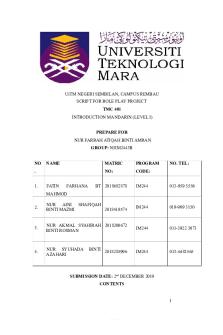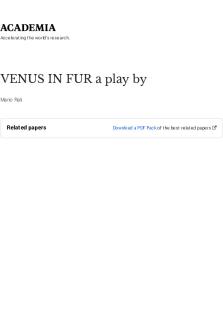Shakuntala and Rasa in the play PDF

| Title | Shakuntala and Rasa in the play |
|---|---|
| Course | Great Works Of Literature I |
| Institution | Baruch College CUNY |
| Pages | 6 |
| File Size | 107.6 KB |
| File Type | |
| Total Downloads | 39 |
| Total Views | 127 |
Summary
Sakuntala ...
Description
Shakuntala and Rasa in the play
Kalidasa composed the poem during the fifth century mentioning every event that occurred in the life of Sakuntala, in this romantic comedy-drama 'Sakuntala and the Ring of Recollection'. The play comprises characters from high caste society who communicate in Sanskrit and low caste society who communicate in Pratik. This play portrays the social structure of India during the rule of the Gupta dynasty. The play is considered to be one of the masterpiece work of Kalidasa as it has the perfect expression of the theory of rasa. The Rasa meaning flavor. However, in the play, it is defined as a strong human feeling or sentiment or emotions.The play is filled with rhythmic
tones
due to the
use
of poem
in
between the
lines
of the
play.
The rasa in Sanskrit drama represents the nine-strong emotions called bhava.This nine fundamental bhav are the emotional feeling we feel in our daily lives which are love, joy, pity, anger, valor, terror, disgust, wonder, and peace. These are the elements which are expressed by the character in the play which has helped give meaning to this love poem and kept the reader's connected to the plot until the end. These types of emotions can be found in most of the indian literatures and acts as the foundation of most of the epic stories. For example, in the epic indian literature ‘Ramayan’, Ravan kidnaps Sita, the wife of Ram because he fell in love with Sita when he went to take revenge for his sister Surpanakha (Ravan’s Sister).Here, we could see that the powerful king Ravana lust and seek
1
for revenge acts as the rasa of the play which gives meaning to the story and makes it more interesting to learn about it. Similarly, ‘Mahabharata’ could be used as another example of the perfect composition of the rasa of the play which is filled with all the strong nine emotions.
Dushyanta and Shakuntala are the main characters of the play. Dushyanta is portrayed as a wise, young and kind king whereas, Shakuntala is portrayed as the young, innocent and beautiful woman.Dushyanta is from the powerful and rich family background whereas, Sakuntala is the nymph daughter. The jealous Lord Indra ordered beautiful nymph to distract the meditation of powerful sage Vishwamitra to stop him from getting more powerful. The background of this two characters are exactly opposite which makes story more interesting because in the old days, marriage of same caste and same social class was only permitted.This custom is still prevalent in India. However, the play shows the pure of of Dushyanta towards Shakuntala. He falls in love at first sight with Shakuntala.His heart was not filled with lust. He didn’t care about her whereabouts but simply, loved her with all his heart. Blinded by love, he performs Gandharva marriage with her. This shows the action of love taken by King Dushyanta . In Shakuntala, Kalidasa has perfectly balanced the nine rasas of Sanskrit literature throughout the story. At the beginning of the plot where we see the king entering the forest to hunt the antelope. Later, the buffoon also mentions that the king hunts for wild beasts every day which depicts the bravery of the king to portray him as the protagonist of the play. On the other hand, Shakuntala is portrayed as a young and beautiful girl who has immense affection for living things. In the Hindu community, ascetics are treated with honor and respect.We can find many powerful ascetics roles in the epic indian literature.Some of the famous wise ascetics names in indian literature are Acharya Charak,
2
Vishwamitra, Chanakya, Kanva etc. They are regarded as wise and powerful men and everyone follows their path and order. Similarly, in the Sakuntala play when ascetics tells King that the antelope belongs to the hermitage, King respects the words of ascetics and does not kill the antelope. This shows the soft corner of King which creates a positive image of King as a dharmic hero
in
the
reader's
mind.
The play also represents conflict of duties and desire. In the play “Shakuntala and the Ring “King
of
Recollection” :My
it
mind
has is
split By Like
By
boulders
mentioned
in
its
in
these a
course.(Act
, two
conflicting river II
current 240
,pg
duties, split 1007)”
Though the king wants to stay with Sakuntala and lead his life. His duties towards his people binds him and separates him from Shakuntala. Similarly, Shakuntala forgets her duty towards the sage Durvasa . Durvasa who feels disrespected and humiliated by Shakuntala places a curse on her. According to the curse, her lover will forget her and only with the symbol of love, the love between them will revive. Here, the duty, desire and anger of Durvasa plays as an important role of rasa for the plot of the story which makes people feel the emotions of pity for Shakuntala. The plot takes a different direction here and now shifts towards the concept of forgetfulness and desire
of
longing.
The King forgets Shakuntala because of the curse and Shakuntala loses the symbol of her love given by King Dushyanta. Her only hope to be recognized by King is shattered. The king
3
humiliates her in the palace which breaks Shakuntala’s heart and leaves her in despair. Shakuntala goes to live in heaven with her mother. Afterwards, Menuka sends her to hermitage and lives there. While in the palace, a fisherman brings the ring that Shakuntala lost and the king gains his memory of his love with Shakuntala back.In this part of the story , Kalidasa has tried to put the concept of sanskrit word
“smara” which means love and rememberance and has
given a sense of conclusion to his story to the readers. In the article “The Plays of Kalidasa: Treading the Line between Constraint and Freedom.”, it says that the test of love in Kalidasa’s plays is in the ability to remember.I completely agree with this statement because the beauty of this story lies in the ability to remember. The final rasa of courage and joy is portrayed in the story when King goes to heaven to fight with deities who gives him the permission to reunite with Shakuntala . The final act of the story brings joy to every reader because the family get reunited. Not only, Dushyanta plays the role of a king but also fulfills his duty of being a father and
a
good
husband.
The whole plot of the story runs with the concept of forgetfulness and desire to meet . This could be referred as the main rasa of the play. Like most of the Indian literature, the story of Shakuntala keeps readers intact with the play because of perfectly, blended rasa in the play. The readers get to feel happy for her love, sad for her curse, angry at king for not recognizing Shakuntala. Throughout the play, this romance comedy story is able to grab the emotions of readers from the emotions of characters. Kalidasa has maintained the push and pull effect of time and the memory and forgetfullness with the metaphor “looking back” which keep repeating in his plays adding perfect spice for reader to enjoy the story.
4
References: Chakrabarti, Sukanya. “The Plays of Kalidasa: Treading the Line between Constraint and Freedom.” Journal of Architecture, Planning and Construction Management, 11 July 2016, journals.iium.edu.my/asiatic/index.php/AJELL/article/view/1112. Gerow, Edwin. “Plot Structure and the Development of Rasa in the Śakuntalā. Pt. I.” Journal of the American Oriental Society, vol. 99, no. 4, 1979, pp. 559–572. JSTOR, JSTOR, www.jstor.org/stable/601446.
5
References: Chakrabarti, Sukanya. “The Plays of Kalidasa: Treading the Line between Constraint and Freedom.” Journal of Architecture, Planning and Construction Management, 11 July 2016, journals.iium.edu.my/asiatic/index.php/AJELL/article/view/1112. Gerow, Edwin. “Plot Structure and the Development of Rasa in the Śakuntalā. Pt. I.” Journal of the American Oriental Society, vol. 99, no. 4, 1979, pp. 559–572. JSTOR, JSTOR, www.jstor.org/stable/601446.
6...
Similar Free PDFs

Shakuntala and Rasa in the play
- 6 Pages

Project 1 - WHY PLAY IN THE ASHL
- 2 Pages

Project 1 - WHY PLAY IN THE ASHL
- 2 Pages

TABULA RASA
- 208 Pages

JWDrama-and-play
- 5 Pages

Emergent Curriculum and Play
- 2 Pages

ROLE PLAY TMC401 - role play
- 10 Pages

Mandragola - notes on the play
- 5 Pages

mengenal diri melalui rasa hati.pdf
- 185 Pages

VENUS IN FUR a play by
- 76 Pages

Resumen Tabula rasa
- 4 Pages
Popular Institutions
- Tinajero National High School - Annex
- Politeknik Caltex Riau
- Yokohama City University
- SGT University
- University of Al-Qadisiyah
- Divine Word College of Vigan
- Techniek College Rotterdam
- Universidade de Santiago
- Universiti Teknologi MARA Cawangan Johor Kampus Pasir Gudang
- Poltekkes Kemenkes Yogyakarta
- Baguio City National High School
- Colegio san marcos
- preparatoria uno
- Centro de Bachillerato Tecnológico Industrial y de Servicios No. 107
- Dalian Maritime University
- Quang Trung Secondary School
- Colegio Tecnológico en Informática
- Corporación Regional de Educación Superior
- Grupo CEDVA
- Dar Al Uloom University
- Centro de Estudios Preuniversitarios de la Universidad Nacional de Ingeniería
- 上智大学
- Aakash International School, Nuna Majara
- San Felipe Neri Catholic School
- Kang Chiao International School - New Taipei City
- Misamis Occidental National High School
- Institución Educativa Escuela Normal Juan Ladrilleros
- Kolehiyo ng Pantukan
- Batanes State College
- Instituto Continental
- Sekolah Menengah Kejuruan Kesehatan Kaltara (Tarakan)
- Colegio de La Inmaculada Concepcion - Cebu




